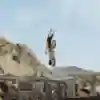
What's life like for Tom Pagès these days?
Over the last few years, I've been concentrating on preparing for this project. I've been to the mountains a lot, and I've developed the equipment for the bike. It's really been a matter of designing and learning. It's been a month since it was finished, so it's still very new. At the same time, I still do a bit of motorcycling. Not so much freestyle, not so much jumping, but more speed and pleasure riding. I've also continued to do sand races in winter, such as the Enduropale du Touquet.
You're passionate about BASE jumping, but you come from a background that's quite far removed from this discipline. What led you to try it?
I started skydiving quite a few years ago now, and then I met Fred Fugen and Vince Reffet from the Soul Flyers. That's when the Flight Mode project was born. Today, I don't do it any more because I don't have the level... I'd have to start from scratch, do skydiving again and so on. I've done paragliding again, I've jumped from helicopters. But from a cliff, that's a different thing. You really have to be prepared.
In terms of preparation, how do you go about it?
You have to do a lot of jumps and be prepared. You need to have some automatisms, especially when you open the parachute, which is the pivotal moment of the jump. There are other important moments, such as the start, because if you don't take off properly, you may not have enough time to stabilise before the parachute opens. It's a sport you have to practise very regularly.
As someone who is used to speed, gravity and risk, how do you deal with fear and stress? Do you have any mechanisms or routines for overcoming it during projects like Ride & Fly?
In any case, there is stress, and you have to deal with it. What I tell myself is that you have to be ready. If you know you're ready, statistically, nothing's going to happen to you. That's how I work. The better your preparation, the better your chances. When the time comes, you're always under a lot of stress, but you know that if you're there, it's for a reason.
Where did the idea for Ride & Fly come from?
It came after the Flight Mode project, where the original idea was to do a BASE jump and stay on the bike when the parachute opened. But it wasn't technically possible at the time. After the project, with my colleagues, with Valentin Delluc, we discussed and imagined how we could stay in the parachute with the motorbike. The most obvious solution was not to jump but to take off. From there, the idea came to learn to fly with the bike and to combine all that, but with small canopies so that we could stay close to the ground and not just do a paragliding flight. I had to learn a lot of things because I didn't know anything about paragliding. There were lots of things I tried to do on my own, but fortunately, I was able to turn to fellow specialists like Valentin Delluc, his team-mate Ugo Gerola and a local, Pacôme Schmitt, who also knows the spots well and helped me enormously with the phases of the flight.
Your family has a penchant for extreme sports...
I don't know. Maybe it comes from my father (laughs). I have the feeling that my brother was even more committed than me. I tend to think that what I'm doing isn't that extreme, so that reassures me. What's complicated is when you're the only one doing something: you don't really know where the limit is. When you're in the total unknown, like on Ride & Fly, you never really know where you stand, so you don't take any risks.
All in all, how long did you train for?
Two and a half years. I did four disciplines at the same time to learn the aerology and the finer points of landing. I wanted to know how to do everything, and that really helped me because the landing was very complicated at the start. I don't live in the mountains, so I had to go back and forth a lot [to Morzine-Avoriaz], and sometimes the weather doesn't allow you to fly. It took a lot of time on-site to make a few flights, it wasn't an easy project, and it was very time-consuming.
What's it like paragliding with a motorbike? It must drastically change your manoeuvrability, right?
Yes, you don't do the same thing at all. After that, maybe if I'd got better I could have done it, because I got better with each flight. In total, I must have done 80 flights. It can look easy and very slow; you think you can do what you want until the bike passes a point, at which point it plunges and it becomes complicated to straighten out.
Aren't there any air holes when you're flying so low?
The danger is mainly on the ground, with the impact. We really chose the weather, and it was always early in the morning or late at night to avoid thermal shock. When the ground warms up, the cold air descends, and that's not pleasant in flight. As soon as the wind blew a bit too hard, we didn't go either. That's why, over a week, flying one day with the bike was not bad.
What's the biggest challenge in making a video like this?
When I launched the project, I thought it would be a lot easier. In the end, it turned out to be so complicated that, at times, I didn't really believe in it anymore because there were so many problems. The glider was impassable with the motorbike, and take-offs were inconceivable, but I realised this as I worked on the project. Developing the equipment and imagining it was also extremely complicated.
How did you go about developing the equipment?
First, we had to develop a system for attaching the harness to the bike. Once that was done, I hung the bike from the ceiling of my garage to see if it was balanced, fitted the karabiners, thought about the positioning of the sail and so on. Once you've done all that, you have to check that it works, that it's the right steering system, that the straps are strong enough, etc. I've had a lot of discussions with people about this. I had a lot of discussions with Red Bull, and in the end, everything went very well.
You're known for being a very innovative person. Aren't you under constant pressure to come up with something new?
People ask me all the time if I've got a new project, and when I tell them I haven't, they don't believe me. Even during those two years, people were waiting. I say to myself, "I hope it's up to scratch." It's something that stresses me out a bit. I hope people like it.
Is there a project you have in mind at the moment that you'd like to do?
Plenty, it's just a question of getting them off the ground now. Up until now, I've really been concentrating on Ride & Fly and doing nothing else. The last thing I wanted to do was break a wrist or something before I could finish it. In general, I always work like that, even when I was doing FMX. I'm very rigorous about not hurting myself. Now that my mind is a bit freer, I'll have to think about what's next. I'm at the same point as I was after Flight Mode. I'm letting the pressure off, but it's true that I always have ideas that are a bit stupid and even crazier. It's just a question of putting it down on paper and thinking about it because it's still going to take a lot of development.
In a different style?
Always the same. Every time I fly, I learn a lot, and it opens doors for me; I see possibilities in terms of flying, motorcycling... there will be even more risks, so we'll have to see if it's worth it.












